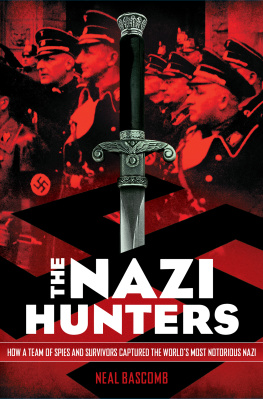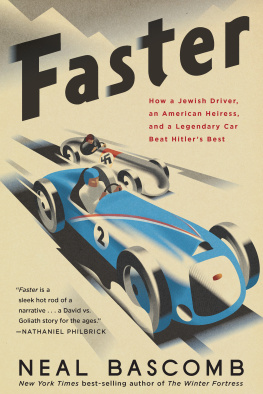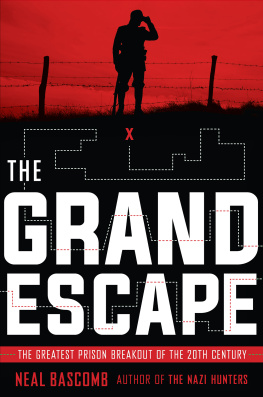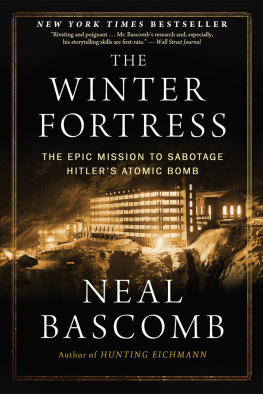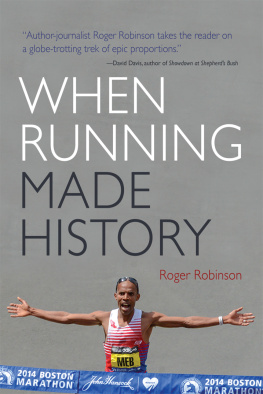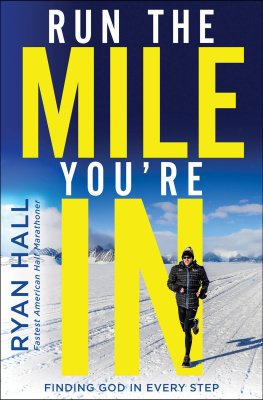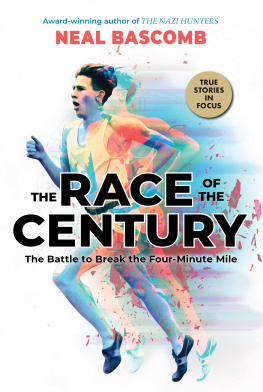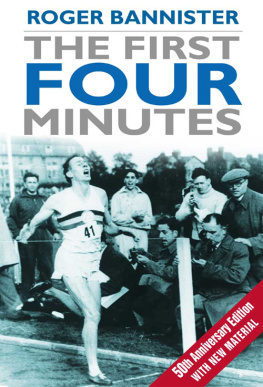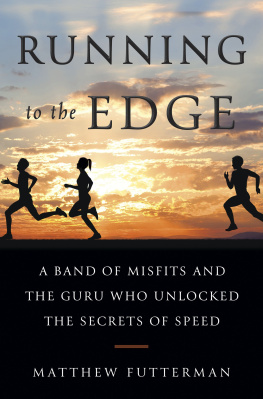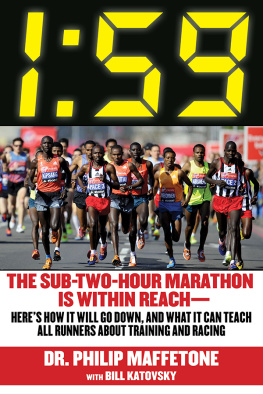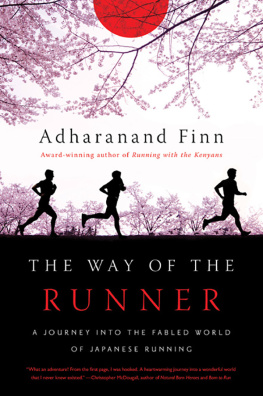A MARINER BOOK
HOUGHTON MIFFLIN COMPANY
BOSTON NEW YORK
To Diane
First Mariner Books edition 2005
Copyright 2004 by Neal Bascomb
All rights reserved
For information about permission to reproduce selections
from this book, write to Permissions, Houghton Mifflin Company,
215 Park Avenue South, New York, New York 10003.
Visit our Web site: www.houghtonmifflinbooks.com.
Library of Congress Cataloging-in-Publication Data
Bascomb, Neal.
The perfect mile : three athletes, one goal, and less than four
minutes to achieve it / Neal Bascomb.
p. cm.
ISBN 0-618-56209-5 (pbk.)
ISBN 0-618-39112-6
1. Bannister, Roger. 2. Landy, John, 1930 3. Santee, Wes.
4. RunnersBiography. I. Title.
GV 1061.14. B 38 2004
796.42'092'2dc22 [B]
2004040535
Book design by Melissa Lotfy
Printed in the United States of America
QUM 10 9 8 7 6 5 4 3 2 1
Lines from "If" by Rudyard Kipling are reprinted by
permission of A. P. Watt Ltd. on behalf of the National Trust
for Places of Historic Interest or Natural Beauty.
Contents
PROLOGUE
PART IA REASON TO RUN ~
PART IITHE BARRIER ~
PART IIITHE PERFECT MILE ~
EPILOGUE
Author's Note
Acknowledgments
Notes
Index
Prologue
If you can force your heart and nerve and sinew
To serve your turn long after they are gone,
And so hold on when there is nothing in you
Except the Will which says to them: "Hold on!"
RUDYARD KIPLING , "If"
"H OW DID HE KNOW he would not die?" a Frenchman asked of the first runner to break the four-minute mile. Half a century ago the ambition to achieve that goal equaled scaling Everest or sailing alone around the world. Most people considered running four laps of the track in four minutes to be beyond the limits of human speed. It was foolhardy and possibly dangerous to attempt. Some thought that rather than a lifetime of glory, honor, and fortune, a hearse would be waiting for the first person to accomplish the feat.
The four-minute mile: this was the barrier, both physical and psychological, that begged to be broken. The number had a certain mathematical elegance. As one writer explained, the figure "seemed so perfectly roundfour laps, four quarter miles, four-point-oh-oh minutesthat it seemed God himself had established it as man's limit." Under four minutesthe place had the mysterious and heroic resonance of reaching sport's Valhalla. For decades the best middle-distance runners had tried and failed. They had come to within two seconds, but that was as close as they were able to get. Attempt after spirited attempt had proved futile. Each effort was like a stone added to a wall that looked increasingly impossible to breach.
But the four-minute mile had a fascination beyond its mathematical roundness and assumed impossibility. Running the mile was an art form in itself. The distanceunlike the 100-yard sprint or the marathonrequired a balance of speed and stamina. The person to break that barrier would have to be fast, diligently trained, and supremely aware of his body so that he would cross the finish line just at the point of complete exhaustion. Further, the four-minute mile had to be won alone. There could be no teammates to blame, no coach during halftime to inspire a comeback. One might hide behind the excuses of cold weather, an unkind wind, a slow track, or jostling competition, but ultimately these obstacles had to be defied. Winning a footrace, particularly one waged against the clock, was ultimately a battle with oneself, over oneself.
In August 1952 the battle commenced. Three young men in their early twenties set out to be the first to break the barrier. Born to run fast, Wes Santee, the "Dizzy Dean of the Cinders," was a natural athlete and the son of a Kansas ranch hand. He amazed crowds with his running feats, basked in the publicity, and was the first to announce his intention of running the mile in four minutes. "He just flat believed he was better than anybody else," said one sportswriter. Few knew that running was his escape from a brutal childhood.
Then there was John Landy, the Australian who trained harder than anyone else and had the weight of a nation's expectations on his shoulders. The mile for Landy was more aesthetic achievement than footrace. He said, "I'd rather lose a 3:58 mile than win one in 4:10." Landy ran night and day, across fields, through woods, up sand dunes, along the beach in knee-deep surf. Running revealed to him a discipline he never knew he had.
And finally there was Roger Bannister, the English medical student who epitomized the ideal of the amateur athlete in a world being overrun by professionals and the commercialization of sport. For Bannister the four-minute mile was "a challenge of the human spirit," but one to be realized with a calculated plan. It required scientific experiments, the wisdom of a man who knew great suffering, and a magnificent finishing kick.
All three runners endured thousands of hours of training to shape their bodies and minds. They ran more miles in a year than many of us walk in a lifetime. They spent a large part of their youth struggling for breath. They trained week after week to the point of collapse, all to shave off a second, maybe two, during a mile racethe time it takes to snap one's fingers and register the sound. There were sleepless nights and training sessions in rain, sleet, snow, and scorching heat. There were times when they wanted to go out for a beer or a date yet knew they couldn't. They understood that life was somehow different for them, that idle happiness eluded them. If they weren't training or racing or gathering the will required for these efforts, they were trying not to think about training and racing at all.
In 1953 and 1954, as Santee, Landy, and Bannister attacked the four-minute barrier, getting closer with every passing month, their stories were splashed across the front pages of newspapers around the world, alongside headlines about the Korean War, Queen Elizabeth's coronation, and Edmund Hillary's climb toward the world's rooftop. Their performances outdrew baseball pennant races, cricket test matches, horse derbies, rugby matches, football games, and golf majors. Ben Hogan, Rocky Marciano, Willie Mays, Bill Tilden, and Native Dancer were .often in the shadows of the three runners, whose achievements attracted media attention to track and field that has never been equaled since. For weeks in advance of every race the headlines heralded an impending break in the barrier: "Landy Likely to Achieve Impossible!"; "Bannister Gets Chance of 4-Minute Mile!"; "Santee Admits Getting Closer to Phantom Mile." Articles dissected track conditions and the latest weather forecasts. Millions around the world followed every attempt. When each runner failedand there were many failureshe was criticized for coming up short, for not having what it took. Each such episode only motivated the others to try harder.
They fought on, reluctant heroes whose ambition was fueled by a desire to achieve the goal and to be the best. They had fame, undeniably, but of the three men only Santee enjoyed the publicity, and that proved to be more of a burden than an advantage. As for riches, financial reward was hardly a factorthey were all amateurs. They had to scrape around for pocket change, relying on their hosts at races for decent room and board. The prize for winning a meet was usually a watch or a small trophy. At that time, the dawn of television, amateur sport was beginning to lose its innocence to the new spirit of "win at any cost," but these three strove only for the sake of the attempt. The reward was in the effort.
After four soul-crushing laps around the track, one of the three finally breasted the tape in 3:59.4, but the race did not end there. The barrier was broken, and a media maelstrom descended on the victor, yet the ultimate question remained: who would be the best when they toed the starting line together?
Next page

